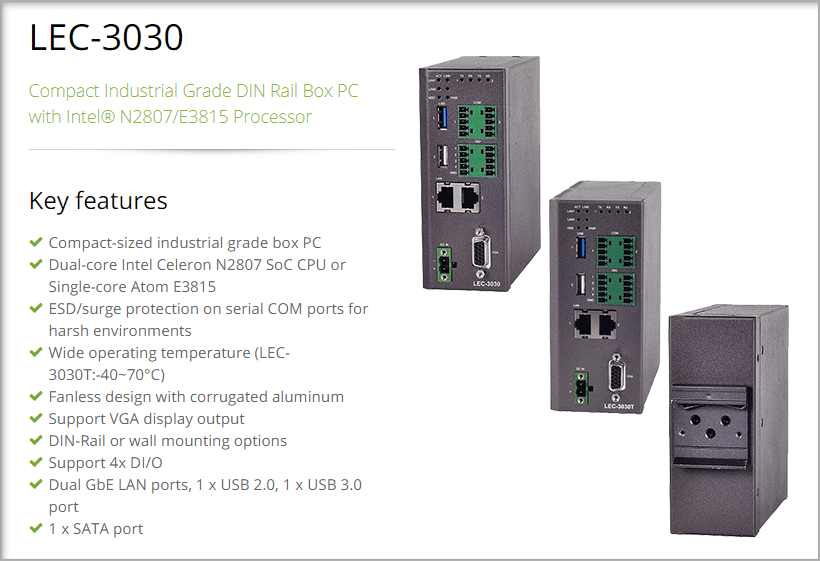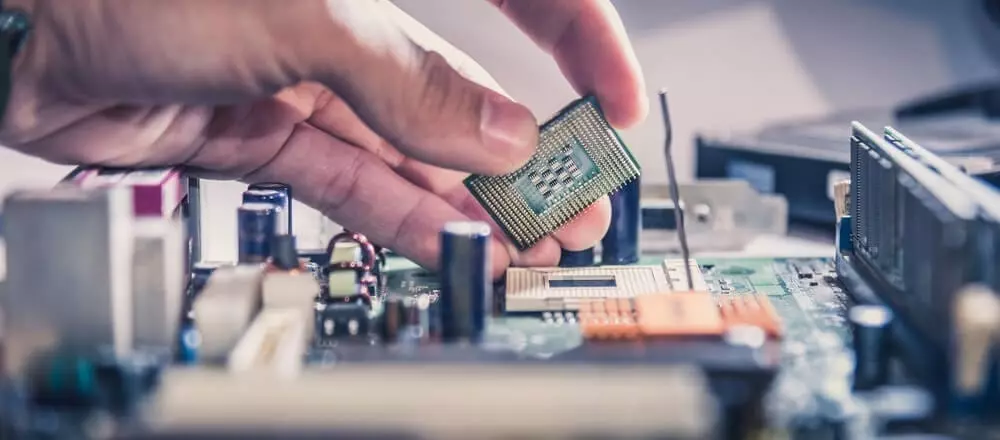
In a nutshell, the motherboard form factor indicates the shape and size specifications of the board. The form factor also determines additional parameters such as the casing, power supply, mounting holes, and overall physical layout.
The first form factor dates back to 1983. At that time, IBM built the personal computer XT and since the form factor specs were open, many manufacturers used it as a de facto standard.
Today the technology landscape has changed. The original motherboard XT form factor evolved to 40 different forms, all deviating from the traditional personal computer use case. IBM is no longer the most popular motherboard builder, there are other manufacturers such as Intel, ASUS, VIA, ABIT, and more. There are motherboards built for embedded systems, rackmount servers, mobiles, media centers, vehicles, and more.
So, What is Motherboard Form Factor 🤔?
The motherboard is the main component, based on its function, of the internal structure of all computers. Mainly responsible for the interaction of all the elements of the computer, such as the CPU, RAM, storage, graphics card, I/O, among others.
It is extremely important to recognize its capabilities, limitations as well as the main features it contains so as not to repress the potential of any other piece within the PC. Another key element is the form-factor (exterior physical size and shape) which also should be considered for the computer application according to the field where it’ll be used.
Motherboards are always characterized by their chipset, type of processor socket, and their form factor.
The following is a picture showing the most important Motherboard Components. The motherboard in the picture is the X570 AORUS PRO and its components are:
- CPU and CPU socket.
- RAM, DRAM, and RAM slots.
- ATX power supply.
- IDE Connectors
- Northbridge and southbridge.
- PCE Slot
- CMOS Backup Battery
- Integrated connectors for peripherals such as USB, mouse, keyboard, display, audio, Ethernet, etc.
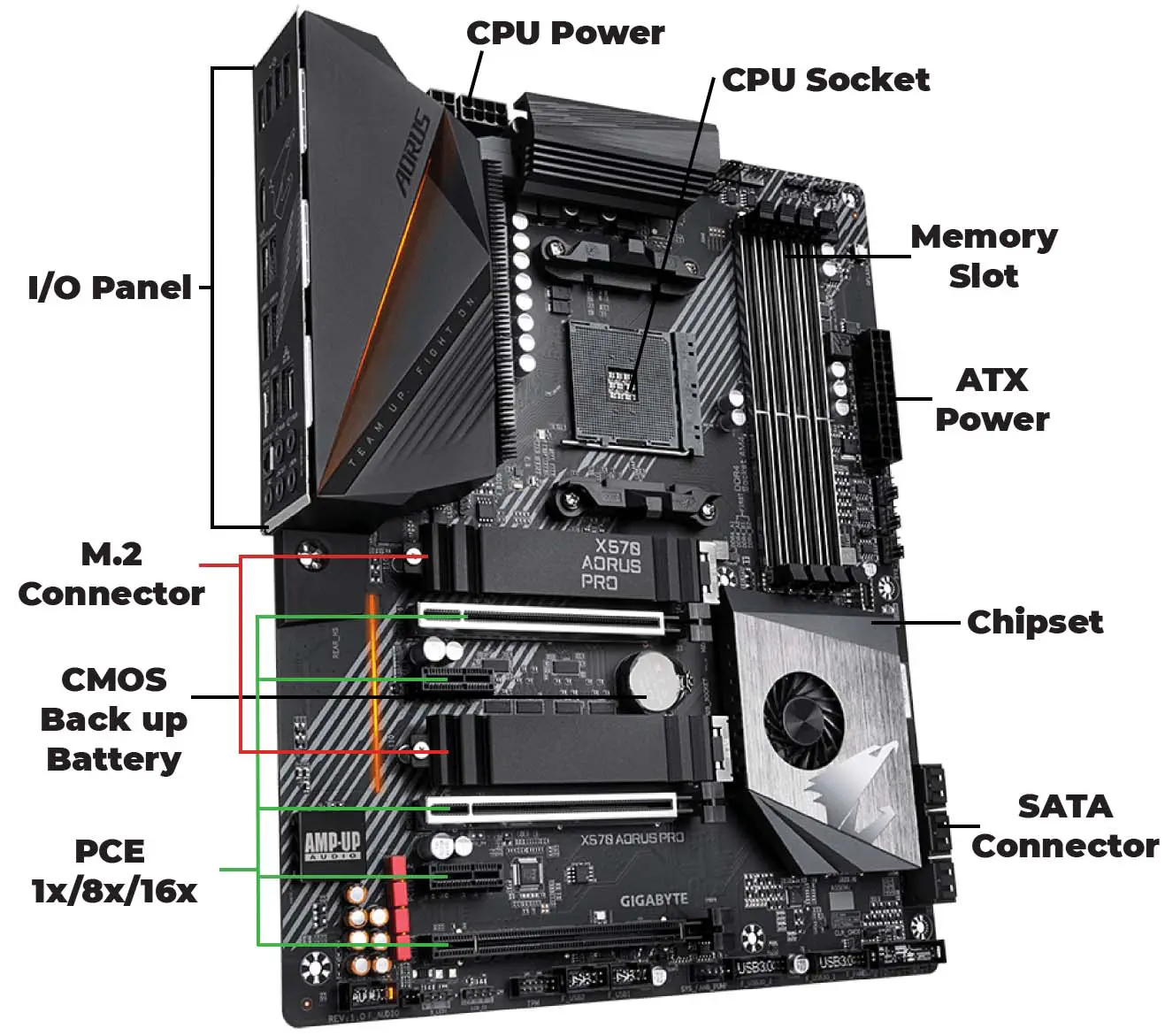
The form factor for this specific motherboard, the X570 AORUS PRO, is the ATX Form Factor; 30.5cm x 24.4cm dimensions.
In this article we’ll focus mainly on this feature, reviewing a list of the most common different form factors and their benefits, especially lower footprint to make computers more cost-effective.
Types of Motherboard Form Factors
≫ Form Factor ATX (Advanced Technology Extended)
Designed as an evolution of the Baby AT form factor, ATX marks a profound change in the architecture of the motherboard and other components such as the cabinet and the power supply.
Within the motherboard there are significant changes such as the location of the CPU socket, which is now placed near the power supply, thus allowing the flow of air caused by the fan of the source and not to be interfered with by any element as it happened with the technology Baby AT.
Another change was the connection between the source of the feed. Which is now a single connector, unlike the AT which were two. Some of the most important improvements for ATX and benefits are:
- Integrated input and output ports
- Slots of expansion without interference
- Start Control by software
- 3 Vol. from the source (reduces hardware cost, energy consumption, and heat)
- A better airflow
- Less interference in access to drive bays.
The ATX motherboard dimensions are 12 × 13 in. A variation of the ATX is the Mini ATX, which is essentially a reduced-size version of ATX but more reduced in terms of its shape, its measurements are 11.2 × 8.2 inches.
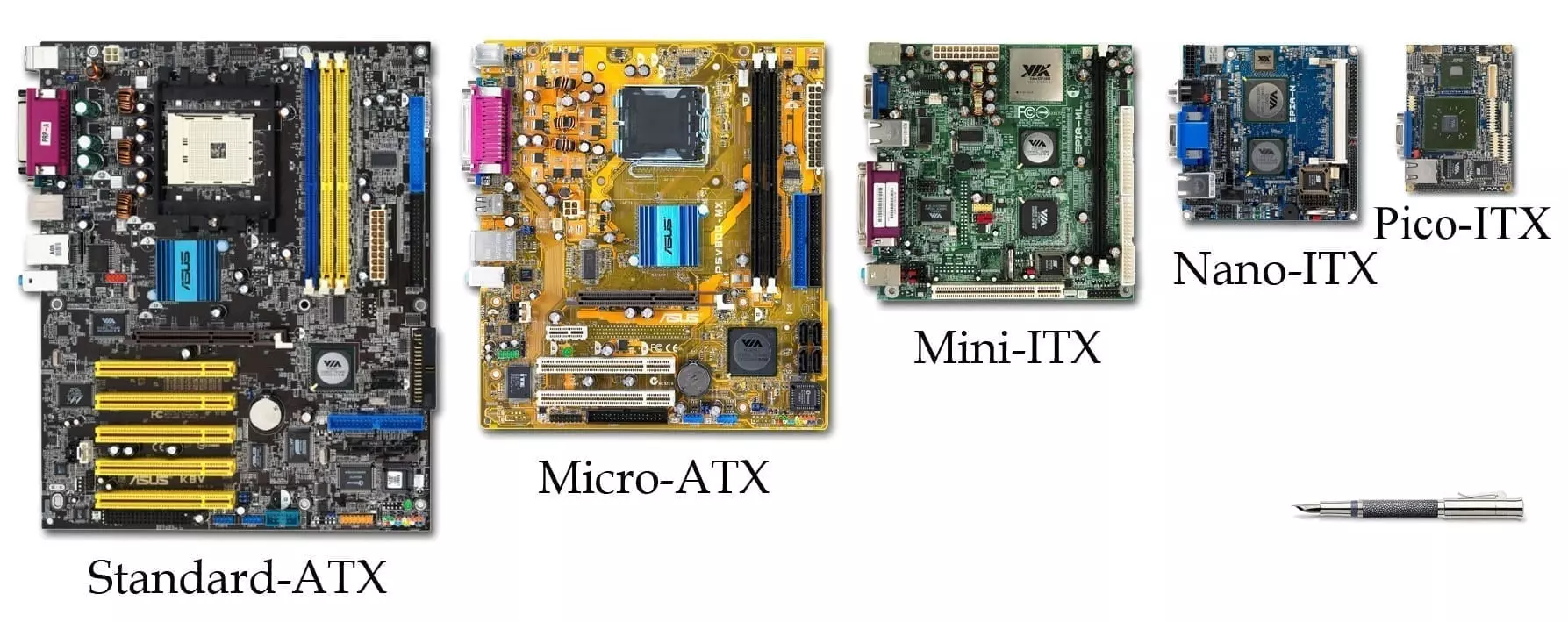
This form factor is the most used today, especially on desktop computers, and after this technology was released several other factors where based on it. Such as the Mini-ITX, Mini-ATX, Micro-ATX, Nano ITX, and Pico-ITX.
≫ Form Micro ATX
It is an evolution of ATX. Its measures are 9.6 × 9.6 inches. The Micro-ATX supports up to four expansion slots that can combine freely with ISA, PCI, PCI / ISA shared, and AGP. Mounting holes changed from the Standard ATX, since the measurements are different, but they are also compatible with most ATX cabinets.
This type of motherboard form factor supports both Intel and AMD processors. It is commonly used on Small Form Factor Desktop Computers.
≫ Form Micro Mini-ITX
Mini ITX is a low-power consumption motherboard format of 6.7 × 6.7 inches. Its dimensions are the most characteristic factor of this type of form factor. Although this type of motherboard was designed with the aim of empowering teams of low consumption, at present there are no limits and they have grown by giant steps in terms of benefits.
Since the Mini-ITX was introduced they have expanded in all kinds of applications, thanks to their open standard factor. Mini ITX is a standard format for all types of equipment, such as vehicle embedded computers, industrial applications, and IoT. The Mini-ITX is the first standard system of reduced format that is popularized, reaching all types of projects and any equipment where it may be necessary.
≫ Form Micro Nano-ITX
The Nano-ITX is another type of motherboard form factor, that measures 4.7 × 4.7 in. Nano-ITX are fully integrated boards designed to consume very low power. This type of motherboard can be used in many applications, but it was specially designed for smart entertainment, like PVRs, media centers, smart TVs, in-vehicle devices, and more.
≫ Form Micro Pico-ITX
The Pico-ITX is the smallest type of motherboard form factor in this list. Its measurements are 3.9 × 2.8 in and it is 75% smaller than the Mini-ITX. This motherboard was designed and developed by VIA, to open up innovation for smaller and smarter IoT devices.
The Pico-ITX with an x86-based-platform and low-power consumption board is a great choice for embedded systems applications, such as industrial automation, in-vehicle computers, digital signage, and more.
Brief Comparison of the Motherboard Form Factors.
Below is a chart comparing the most popular motherboard form factors.
| Form Factor | Manufacturer/Date | Dimensions | Applications |
| Standard-ATX | Intel 1995 | 12 × 9.6in | Workstation/Desktop |
| Micro-ATX | Intel 1997 | 9.6 × 9.6 in | Small Form Factor |
| Mini-ITX | VIA 2001 | 6.7 × 6.7 in | Small Form Factor |
| Nano-ITX | VIA 2003 | 4.7 × 4.7 in | Embedded Systems |
| Pico-ITX | VIA 2007 | 3.9 × 2.8 in | Embedded Systems |
| Mobile-ITX | VIA 2009 | 2.4 × 2.4 in | Embedded Systems |
Below is a motherboard form factor size chart. This comparison picture helps understand the differences in dimensions for the most popular motherboard form factors.
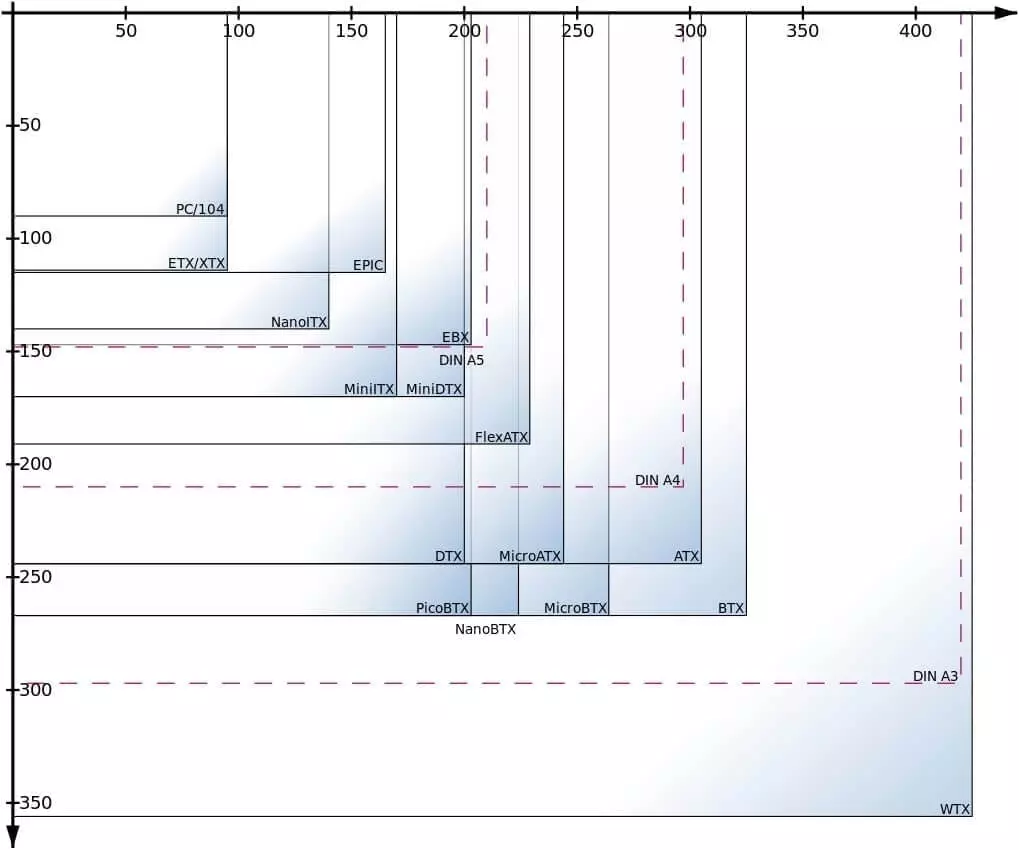
Form Factors and Some of Their Applications
In-Vehicle Computers
Due to its really reduced format, yet powerful performance, the Mini-ITX systems can be installed in vehicles’ reduced spaces in order to communicate real-time tracking and monitoring systems.
On example of a Mini- ITX solution is Lanner’s V3G, which is a rugged fanless vehicle computer. V3G is powered by the new generation 14 nm Intel® Atom™ x7-E3950 SoC (formerly Apollo Lake). This processor consumes low volume of power and offers performance upgrade from previous generation of Atom™ processors, optimized for vehicle computing applications.
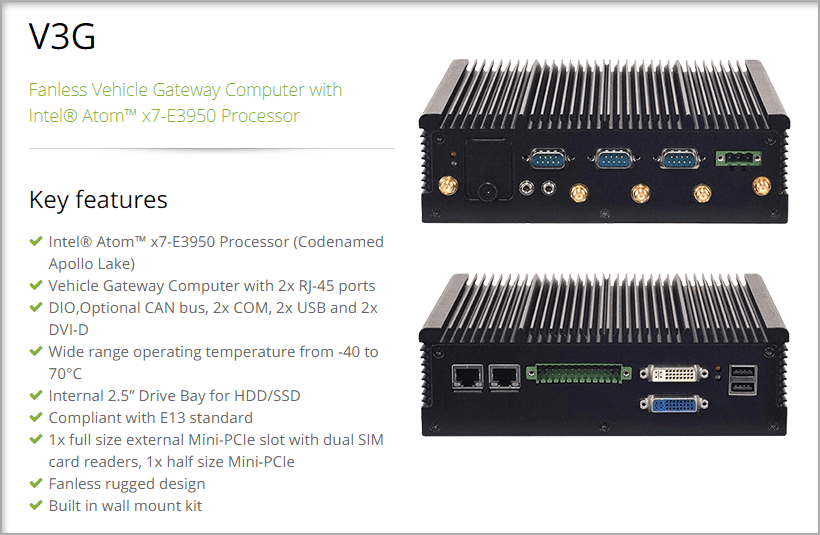
Since wireless network connectivity is one of the most critical requirements, the V3G offers 2 x mini-PCIe sockets with a swappable SIM slot supporting 3G/4G/LTE cellular communications. In addition, the compact system comes with built-in GPS for navigation and multiple antennae I/Os for extended receptions.
As an in-vehicle computer, V3G boasts an abundance of I/O peripheral connectivity including 2 x serial COM ports, 2 x video output by DVI-D, USB, and Digital I/O ports, and 2 x RJ-45 LAN ports to work with other components and subsystems in armored vehicles. For storage, V3G comes in SATA/mSATA storage options.
Lanner’s V3G is a great solution in this case due to its certified LTE wireless connectivity and Military-grade ruggedness.
IoT Devices
Smart LED street illumination has been embraced by multiple municipal governments worldwide, as the starting point for IoT-based smart city establishment. Since the street lighting infrastructure already exists, many city planners take smart lighting as the opportunity to enable their IoT foundation by consolidating sensors, wireless communication points, and open-interface technologies. In order to work with whole these elements at an external environment, the requirements that should be considered are abundant I/O ports, LTE connectivity, Wide Operating Temperature and (of course) being a reduced form factor.
One example of IoTs street illumination solution is Lanner’s LEC-3030T a compact communication white-box IIoT gateway to meet the demands for smart LED street lighting. The gateway is physically designed in compact form factor and fanless thermal mechanism to meet the outdoor setting. Since extreme temperature is a potential challenge in an outdoor application, LEC-3030T can withstand a wide range of operating temperatures, from as low as -40°C to as high as 70°C.
In terms of the performance, the LEC-3030T is empowered by Intel® Atom™ E3815 processor and DDR3L at 1,333 MHz SO-DIMM memory up to 4GB to adequately perform data collection, analysis and transfer in an end-to-end application. Functioning as the IoT gateway for street lamps, LEC-3030T boasts an abundance of I/O connectors, such as VGA display, serial COM ports (with RS-232/422/485 and ESD/surge protection), digital I/O connector, RJ-45 LAN ports, and USB ports to accommodate various sensors and meters associated with the deployment.
These are only two excellent examples of the benefits of a PC reducing form factor tendency which provides great benefits in space and cost. We have not only reviewed the different form factors but also learned how the form factor enables PC applications in different industries.
Final Words
With the rise of millions of different IoT devices and embedded systems, motherboard design is evolving rapidly. Sizes are changing, and forms are becoming more adaptable to each application.
The size of a device depends on the size of the motherboard. A smartwatch will require a totally different form factor than an industrial IoT device. So the form factor becomes a crucial characteristic when building the device.
The form factor determines the specifications on how a motherboard is built, from the size, shape, casing, power supply, mounting holes, and the overall layout.
The most common form factor is ATX, which evolved to mini-ATX, nano-ATX, pico-ATX, and further. A different type of form factor, and smaller than the ATX is the ITX, which is significantly smaller than the micro-ATX. The ITX form factor can also be found as nano-ITX, pico-ITX, mobile-ITX, and more.
